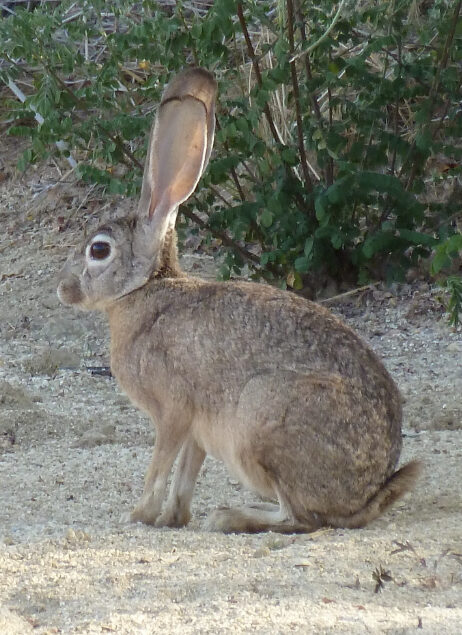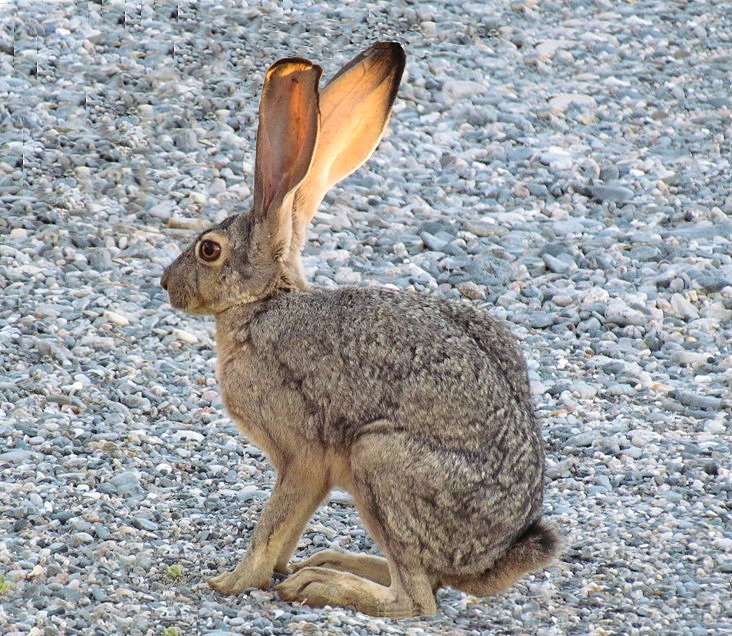Black-tailed Jackrabbit, Lepus californicus
 Black-tailed Jackrabbit, Lepus californicus. Photograph taken in the greater Los Cabos area, Baja California Sur, March 2011.
Black-tailed Jackrabbit, Lepus californicus. Photograph taken in the greater Los Cabos area, Baja California Sur, March 2011.
 Black-tailed Jackrabbit, Lepus californicus. Photograph taken in the greater Bahía de los Ángeles, Baja Calfornia, October 2015. Photograph courtesy of George Flicker, Bahía de los Ángeles, Baja California Identification courtesy of Mary & George Flicker, Bahía de los Ángeles.
Black-tailed Jackrabbit, Lepus californicus. Photograph taken in the greater Bahía de los Ángeles, Baja Calfornia, October 2015. Photograph courtesy of George Flicker, Bahía de los Ángeles, Baja California Identification courtesy of Mary & George Flicker, Bahía de los Ángeles.
The Black-tailed Jackrabbit, Lepus californicus, is a member of the Leporidae family of rabbits and hares. The Leporidae family consists of fifty-four members placed in eleven genera. There are thirty species in the Lepus genus. Despite their name, Black-tailed Jackrabbits are actually hares and not rabbits. Hares are born with fur and are larger than rabbits and have longer ears and taller hindlegs. In Mexico the family is collectively referred to as conejos. The Black-tailed Jackrabbit is known in Mexico as Liebre de Cola Negra.
The Black-tailed Jackrabbit has long distinctive black-tipped ears and long, powerful rear legs. Their dorsal fur is tan brown and peppered with black while their underside and insides of their legs are creamy white. They possess a characteristic black stripe down the center of their back and a black rump patch. Their tail is black dorsally and gray to white ventrally. They have large eyes are placed high and toward the side of their head, allowing them to see almost 360 degrees. Black-tailed Jackrabbits measure 47 cm (18.5 inches) to 63 cm (25 inches) in length and can weigh 1.3 kg (2 pounds 14 ounces) to 3.1 kg (6 pounds 13 ounces). Their distinctive large ears measure 10 cm (3.9 inches) to 13 cm (5.1 inches) in length. Both sexes look alike, but the female is typically larger than the males. They are the third largest North American hare, after the Antelope Jackrabbit and the White-tailed Jackrabbit.
Breeding season for the Black-tailed Jackrabbit extends from December through September in Arizona and from late January to August in California and Kansas. However, in warmer climates they can breed year-round. Males and females will leap after, chase, and behave aggressively towards each other during a brief courtship phase before mating. Their nests are not elaborate and are shallow excavations that are only a few centimeters deep and filled with fur. Females produce 3 to 4 liters annually with 1 to 6 young (typically 3 to 4) per litter with a 41-47 day gestation period. The female move her young, called leverets, to separate locations to make them less vulnerable to predators. Leverets are precocial and are born with fur and their eyes open. They are mobile within a few minutes after birth. Females nurse their offspring for three to four days and are not seen with their young after that time. Leverets become fully independent after one month. On average the Black-tailed Jackrabbit have life spans of two to five years in the wild.
Black-tailed Jackrabbits are solitary and nocturnal, usually spending their day resting in a scraped out hollow in the shade. They can survive on poor-quality foods and obtain most or all of the water they need from their food. In the summer, they eat a wide variety of green plants (shrubs, small trees, grasses) and in the winter they primarily consume dried and woody plants. One of their favorite foods is alfalfa. Jackrabbits eat almost constantly and consume large quantities relative to their size. Fifteen jackrabbits can eat as much as a large grazing cattle in one day. They cope with extreme heat by lowering their metabolism, resting in the shade during the day, and using their large ears for cooling. They are non-migratory, with a home range of about one square mile, and they do not hibernate. They are plagued by ectoparasites including fleas, ticks, lice and mites. They are an important prey species for raptors and carnivorous mammals such as coyotes, eagles, foxes, hawks, owls, and wild cats. Black-tailed Jackrabbits can run at speeds up to 48.3 km per hour (30 mph) and are tremendous leapers capable of jumping more than 5.5 meters (18 feet) horizontally. When trying to evade predators, they move in a zig-zag pattern and flash the white underside of their tail to confuse the predator and alert nearby jackrabbits of danger.

From a conservation perspective the Black Tailed Jackrabbit is currently considered to be of Least Concern due to their widespread geographic range. A recent survey has indicated a consistent downward trend in the population numbers of most western United States which has been attributed to long term drought, habitat changes, and the cessation of predator control activities. They are also threatened by competition with livestock, habitat fragmentation, human-induced fire, and declining habitat quality. They have a long history as being an agricultural pest and were extensively hunted in the 1800s and 1900s with aggressive rabbit eradicating up to 6,000 animals per day. Today they are common with high population levels and widespread and remain a target of hunters for pest control and sport. Population densities often reach 470 animals per square km, with densities as high as 1,500 animals per square km being recorded. They are not used for human food due to the presence of parasites; their fur has been extensively used as a human in the manufacture of felt and as trimming and lining for garments and gloves.